8. LA RITMITE "CALCARI-MARNE A POSIDONIA" DEL GIURASSICO (TOARCIANO-AALENIANO) NELL'APPENNINO CENTRALE
The marlstone-limestone rhythmite "Calcari e Marne a Posidonia" in the Jurassic (Toarcian-Aalenian) of central Apennines
Collaborators: Elena Morettini (Shell Expl., Rijswijk The Netherlands), and collaborators of Switzerland.
Monaco P. & Morettini E. (2000). Marl-limestone rhythmite and event beds in the Toarcian-Aalenian "Calcari e marne a Posidonia" unit of Fiuminata (Pioraco, Central Apennines). Boll. Serv. geol. d'It., vol CXVI, 1997.
Morettini E., Baumgartner P.O., Hunziker J.C., Monaco P. & Ripepe M. (2000). Stable isotopic signal of Carbon and Oxygen in Jurassic Marlstone-limestone Rhythms (Italy, Central Apennines).In: R.L.Hall and P.Smith (Eds.), Advances in Jurassic Research 2000, GeoResearch Forum vol.6 (2000), Trans Tech Publ., Switzerland: pp.487-498.
© and permission of all colour photographs, text and charts by P. Monaco
La sedimentazione pelagica Giurassica del bacino Umbro-Marchigiano presenta, in virtù di una marcata differenziazione fisiografica e morfologica dei fondali, differenti litotipi in eteropia di facies. Di notevole interesse è una successione ritmica costituita da coppie regolari marne-calcari (Fig.1), che affiora indisturbata e ben esposta per circa 40 metri nell'area di Fiuminata (Pioraco, Appennino Umbro-Marchigiano, Fig.2), di età Toarciano Medio - Aaleniano p.p. Essa viene ascritta all'unità "Calcari e Marne a Posidonia" (CMP) per le numerose analogie con la corrispondente unità Toscana descritta in letteratura.
La ritmite è costituita da 80 coppie marna-calcare, ognuna di 35-40 cm in spessore (Figg.3-4). La semi-coppia marnosa si presenta debolmente bioturbata e presenta una abbondante e ben conservata fauna a foraminiferi bentonici e bivalvi, ma non radiolari. La semi-coppia calcarea, al contrario, è pervasivamente bioturbata e gli abbondanti radiolari si intercalano con frammenti di gusci di bivalvi a causa dell'intensa attività dell'infauna. Packstone-grainstone a bivalvi a guscio sottile (vedi freccia nera in Fig.3) e depositi a stratificazione incrociata hummocky (HCS) si intercalano senza ritmicità alle coppie marna-calcare dell'unità CMP e sono riconducibili a episodiche tempestiti distali provenienti dall'adiacente alto di Pioraco e all'azione di correnti di fondo.
Il presente studio indica che l'area di Fiuminata costituiva un depocentro differenziatosi durante il Giurassico inferiore-medio, ricevendo abbondante argilla che portava alla diluizione del carbonato per tutto il Toarciano e l'Aaleniano, formando una successione ritmica che al passaggio Toariano/Aaleniano sostituisce le caratteristiche e conosciute facies calcareo-selcifere dell'Umbria-Marche.
Il contenuto microfaunistico e le caratteristiche sedimentologiche di ogni coppia indicano: 1) una correlazione inversa, periodica, tra foraminiferi bentonici dominanti nella semi-coppia argillosa e radiolari in quella calcarea; 2) una elevata differenziazione specifica dei foraminiferi bentonici nella porzione argillosa, che diminuisce al limite Toarciano superiore - Aaleniano inferiore; 3) una diversità tessiturale tra semi-coppia marnosa e calcarea a causa del diverso grado di bioturbazione.
I dati suggeriscono un ambiente costantemente favorevole ai bivalvi a guscio sottile e, al contrario, favorevole in modo intermittente ora allo sviluppo dei foraminiferi, ora alla conservazione dei radiolari. La sedimentazione argillosa, apportando nutrienti nel bacino potrebbe aver favorito la proliferazione dei foraminiferi bentonici, a scapito dei radiolari, che viceversa, anche a causa della diagenesi precoce, ben si preservavano nella semi-coppia calcarea.
Le cause responsabili della sedimentazione ritmica sembrerebbero essere state variazioni orbitali cicliche di bassa ed alta eccentricità (rispettivamente 118 e 404 ka), mentre l'organizzazione attuale in coppie marna-calcare veniva enfatizzata dai processi diagenetici (responsabili forse anche della preservazione selettiva dei radiolari). Dalla variazione nello spessore delle semi-coppie traspare l'effetto delle variazioni orbitali tipo bassa eccentricità che innescavano variazioni climatiche e di produttività: cicli di Diluizione con immissione intermittente di argilla nel bacino e cicli di Proliferazione con spiccate oscillazioni nella produttività faunistica.
The Jurassic pelagic sediments of the Umbria-Marche palaeogeographic domain show varied lithologies, mainly due to high physiographic differentiation occurring in the basin from Early to Late Jurassic.
In the area of Fiuminata (Umbria-Marche basin), the "Calcari e Marne a Posidonia" unit (CMP because of its affinity with the Tuscan unit named as such), is represented by a 40 meters thick rhythmic posidoniid-bearing marlstone-limestone couplets (80 in total), each reaching 35-40 cm in thickness (Figs.1-2). Biostratigraphy from ammonites and calcareous nannofossils indicate a Middle Toarcian-Early Aalenian age. The marly portion (Figs.3-4) is poorly bioturbated and shows abundant and well preserved microfaunal content, dominated by benthic foraminifers and bivalves; the limestone portion, on the contrary, is pervasively burrowed and abundant radiolarians are mixed with bivalve shell fragments by intense infaunal activity. Occurring randomly within the marlstone-limestone couplets are thin-shelled bivalve packstones/grainstones (see black arrow in Fig.3), hummocky cross-stratified (HCS) deposits and winnowed beds lacking rhythmic distribution. These beds occur in the lower-middle part of CMP and are related to episodic, distal tempestites or bottom currents.
This study suggests that the area acted as an efficient depocenter, receiving abundant clay that diluted biogenic carbonates, giving way to the substitution of cherty-calcareous facies with the marlstone-limestones alternances.
Microfaunal content and sedimentological features of couplets indicate: 1) a periodic inverse correlation between foraminifers and radiolarians co-varying with lithotypes; 2) high specific differentiation of benthic foraminifers in the marly portion decreasing at the Late Toarcian-Early Aalenian boundary, and 3) different fabrics between marl and limestone semicouplets due to burrowing activity. Data set suggests a constant suitable environment for bivalves, and intermittently favourable conditions for foraminifer development and for radiolaria preservation. The benthic foraminifer bloom in the marly semicouplet is probably linked to nutrients supply brought about by the intermittent clay input in the basin.
Orbital variations of high and short eccentricity type, 118 and 404 ka respectively, have induced the rhythmic arrangement of CMP marl-limestone alternations. Semicouplets were emphasized by the diagenetic overprint. Indeed, the variation of bed thickness closely corresponds to the short eccentricity effect, which drives Dilution and Proliferation cycles based on intermittent clay input in the basin and on oscillations of microfossils assemblages.
A detailed study on changes of the stable isotopic signal on the rhythmite of Fiuminata has been carried out and data set is reported in Morettini et al. (2000).
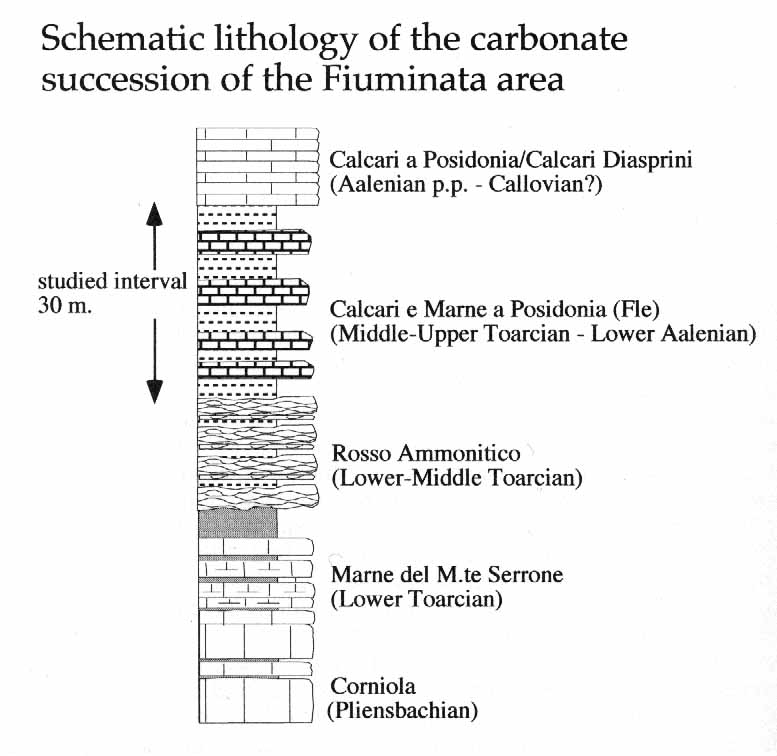
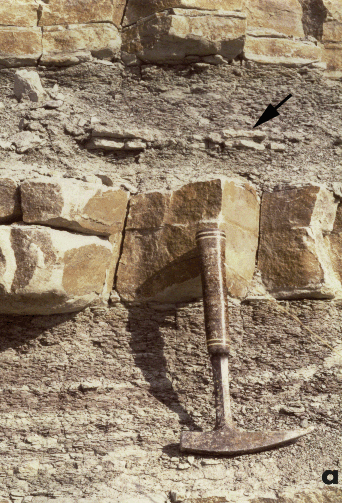
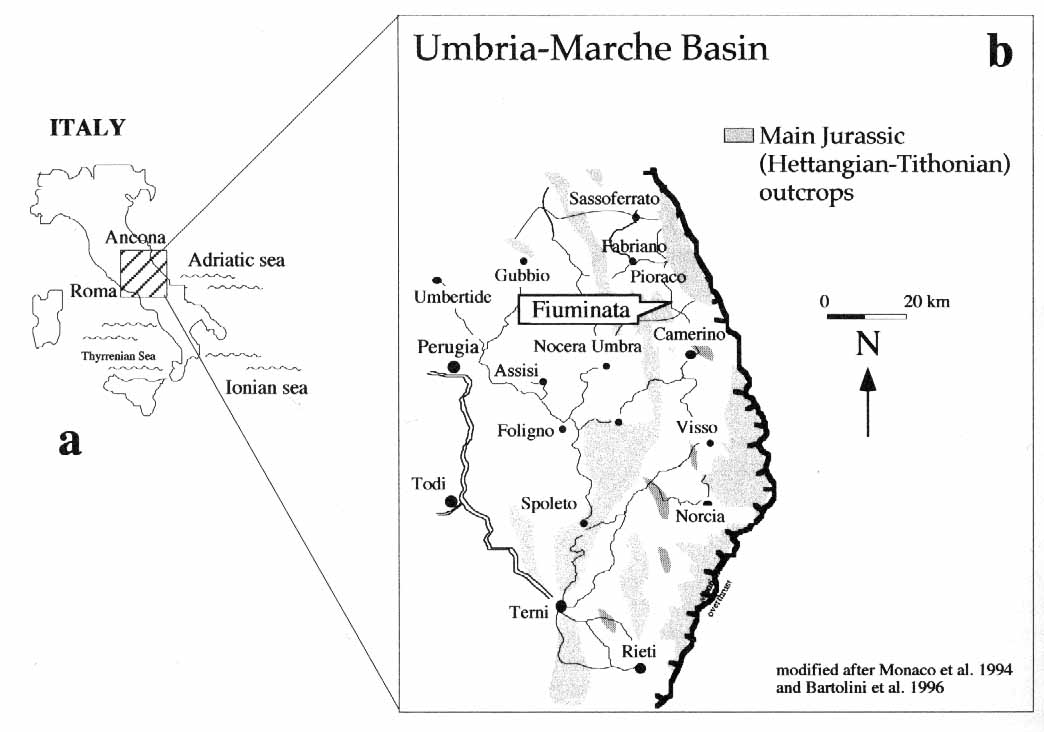
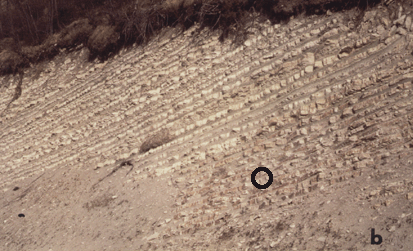
fig.3 is on the circle
Isotopic data of Fiuminata rhythmite (Fig.5):
the delta 13C and delta 18O profiles (E.Morettini and collaborators):
The absolute range of values for delta 13C varies between 0.14 and 2.3 ‰ (click to enlarge Fig. 5). The
average value of delta 13C at Fiuminata is 1.69 ‰. The mean delta 13C value for marlstones is 1.52‰, and ranges from 0.68 to 1.93‰. The mean delta 13C value for limestones is 1.85‰, and ranges from 0.14 to 2.29‰.
The absolute range of values for the delta 18O varies between -2.83 and -1.03‰. The average value for delta 18O is -1.53‰. The difference between marlstones and limestones is present also for delta 18O, though to a smaller extent. The mean delta 18O value for marlstones is -1.63‰, and the absolute the range of values goes from -2.83 to -1.14%o. The mean delta 18O value for limestones is -1.44‰, and range from -2.45 to -1.21‰.The delta 18O signature for marlstones is on average 0.2 ‰ more negative than that for limestones. The average delta 18O difference between adjacent marl/limestones in individual couplets shows a value of 0.2‰. The mean shift recorded for oxygen is therefore by 0.1 ‰ smaller than the shift of the delta 13C.
Marl and calcarcous beds, rich in thin-shelled bivalves, mainly differ in benthic foraminifers abundance and stable isotopic content: marlstones contain abundant foraminifers and show lighter delta 13C and delta 18O isotopic ratios with respect to limestones, which show paucity of benthic foraminifers and heavier delta 13C and delta 18O isotopic ratios.
Isotopic curves and benthic faunal abundances covary rhythmically, enhancing climatic and lithological cyclicities. The mechanism which linked climatic changes to deposition processes seem to go from a dilution cycle, triggered by strong runoff on continental environment, to a proliferation-production cycle which also refiect the chemistry of water column. (From Morettini et al., 2000).
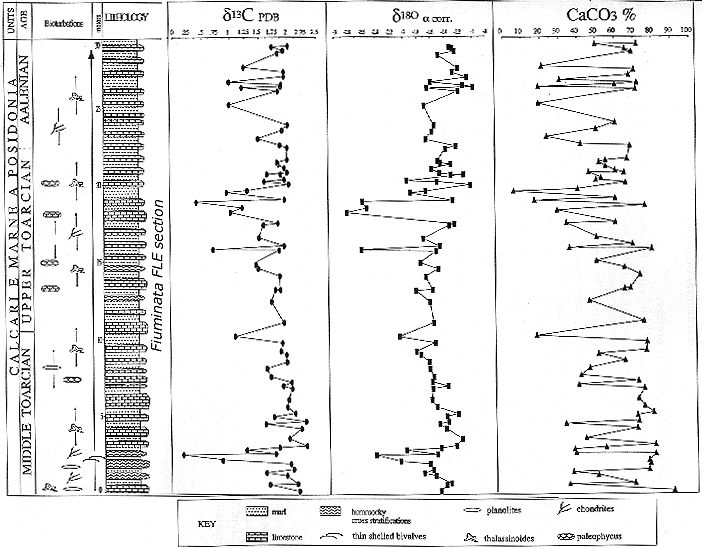
(click to enlarge)
• COLACICCHI R., NOCCHI M., PARISI G., MONACO P., BALDANZA A., CRESTA, S. & PALLINI, G. (1988) - Paleoenvironmental analysis from Lias to Malm (Corniola to Maiolica Formations) in the Umbria-Marche basin, Central Italy (preliminary report). In: R. B. ROCHA &. A. F. SOARES (Eds.), 2nd Int. Symp. on Jurassic Stratigraphy , Lisboa, Sept. 1987, 2: 717-728.
• CONTI M.A. & CRESTA S. (1982) - Considerazioni stratigrafiche e paleontologiche sui "livelli a Posidonia" (Auct.) dell'Appennino Umbro-Marchigiano. Paleontologia Stratigrafica ed Evoluzione, Quaderno n°2: 73-80.
• CONTI M.A. & MONARI M. (1992) - Thin shelled bivalves from the Jurassic Rosso Ammonitico and Calcari a Posidonia Formations of the Umbria-Marche Apennine (Central Italy). Paleopelagos, 2: 192-213.
• CRESTA S., CECCA F., SANTANTONIO M., PALLINI G., BRÖNNIMANN P., BALDANZA A., COLACICCHI R., MONACO P., NOCCHI M., PARISI G. & VENTURI F. (1988). Stratigraphic correlations in the Jurassic of the Umbria-Marche Apennines (Central Italy). In: R. B. ROCHA &. A. F. SOARES (Eds.), 2nd Int. Symp. on Jurassic Stratigraphy Lisboa, Sept. 1987, 2: 729-744.
• EINSELE G. & RICKEN W. (1991) - Limestone-Marl alternations - an Overview. In: W. R. G. EINSELE, W. RICKEN & A. SEILACHER (Eds.), Cycles and Events in Stratigraphy,. Berlin, Heidelberg, New York, Springer Verlag: 23-47.
• EINSELE G., RICKEN W. & SEILACHER A. (1991) - Cycles and Events in Stratigraphy - basic concepts and terms. In: W. R. G. EINSELE, W. RICKEN & A. SEILACHER (Eds.), Cycles and Events in Stratigraphy, Berlin, Heidelberg, New York, Springer Verlag: 1-19.
• EINSELE G. & SEILACHER A. (Eds.). (1982) - Cyclic and Event stratification. Berlin, Heidelberg, New York, Springer Verlag: pp. 536.
• EINSELE G. & SEILACHER A. (1991) - Distinction of tempestites and turbidites. In: W. R. G. EINSELE, W. RICKEN & A. SEILACHER (Eds.), Cycles and Events in Stratigraphy,. Berlin, Heidelberg, New York, Springer Verlag: 377-382.
• KÄLIN O., PATACCA E. & RENZ, O. (1979) - Jurassic pelagic deposits from Southeastern Tuscany; aspects of sedimentation and new biostratigraphic data. Eclogae Geol. Helv., 72 (3): 715-762.
• MONACO P., NOCCHI M., ORTEGA-HUERTAS M., PALOMO I, MARTINEZ F. & CHIAVINI G. (1994) - Depositional trends in the Valdorbia section (Central Italy) during the Early Jurassic, as revealed by micropaleontology, sedimentology and geochemistry. Eclogae geol. Helv., 87 (1): 157-223.
• MORETTINI E., BAUMGARTNER P.O., HUNZIKER J.C., MONACO P. & RIPEPE M. (2000). Stable isotopic signal of Carbon and Oxygen in Jurassic Marlstone-limestone Rhythms (Italy, Central Apennines).In: R.L.Hall and P.Smith (Eds.), Advances in Jurassic Research 2000, GeoResearch Forum vol.6 (2000), Trans Tech Publ., Switzerland: pp.487-498.